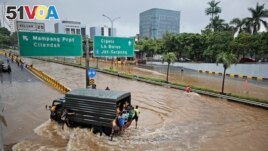06 March 2022
The walls of Saifullah's home in northern Jakarta show the floodwater marks – some more than one meter from the floor.
When the water gets too high, Saifullah, who like many Indonesians only uses one name, sends his family to stay with friends.
"It's a normal thing here," said the 73 year old. "But this is our home. Where should we go?"

FILE - A military truck drives through the water on a flooded toll road following heavy rains in Jakarta, Indonesia, Saturday, Feb. 20, 2021. (AP Photo/Dita Alangkara, File)
Indonesia's capital Jakarta is sinking more than any other major city. Observers say it shows how climate change is making more places unlivable. About 30 percent of the city is expected to be under water in the coming years. This is partly because of the rising Java Sea.
The Indonesian government is planning to move its capital 2,000 kilometers northeast to the island of Borneo. As many as 1.5 million government workers will have to move their homes to the new capital.
It is part of the large movement of people which is expected to increase in the years ahead.
The United Nations published a report on Monday by the Intergovernmental Panel on Climate Change. It says 143 million people will likely be forced to move from their homes over the next 30 years. The reasons include rising sea levels, drought, higher temperatures and other climate catastrophes.
In Asia, governments are already making plans for the future.
More than 30 percent of migrants in the world today come from Asia. Asia leads the world in the number of people being forced to leave their communities because of extreme weather, said the report. Scientists believe migration flows and the need for the planned movements of entire towns and villages will increase.
Under worldwide warming levels some areas "that are presently densely populated will become unsafe or uninhabitable," the report said.
One estimate suggests that as many as 40 million people in South Asia may be forced to move over the next 30 years. The reasons include a lack of water, crop failure, and other disasters.
Rising temperatures are a strong concern, said Stanford University environmental scientist Chris Field. He was responsible for the U.N. report in earlier years.
"There are relatively few places on Earth that are simply too hot to live now," he said. "But it's beginning to look like in Asia, there may be more of those in the future and we need to think really hard about the implications of that."
No nation offers asylum or other legal protections to people displaced because of climate change. The administration of U.S. President Joe Biden, however, has studied the idea.
People leave their homes for many reasons. But what is happening in Bangladesh shows how climate change will force people to move, said Amali Tower. She founded the organization Climate Refugees.
Scientists say as many as 2 million people in the country may be displaced by rising seas by 2050. Already, more than 2,000 migrants arrive at the capital of Dhaka every day. Many are fleeing towns and villages along the coast.
"You can see the actual movement of people. You can actually see the increasing disasters," Tower said.
The migration flows can be slowed if countries like the United States and European nations act to reduce their greenhouse gas emissions to zero, she said. Others say rich countries that produce more emissions should offer humanitarian visas to people from countries that are affected by climate change.
Dealing with climate migrants will become a major policy issue for Africa south of the Sahara Desert and Latin America in coming years, said the U.N. report. Most people will be moving from rural areas to cities. In Asia, about 70 percent of the population could live in cities in the next 30 years.
The migration does not have to cause a crisis, said Vittoria Zanuso. She is executive director of the Mayors Migration Council, an international group of city leaders.
In northern Dhaka, for example, officials are building shelters for climate migrants and improving the water supply. They also are working with smaller cities to become "climate havens" that welcome migrants, Zanuso said.
I'm Susan Shand.
The Associated Press reported this story. Susan Shand adapted it for Learning English.
___________________________________________________________________
Words in This Story
drought – n. an extreme lack of rain
catastrophe – n. a terrible disaster
uninhabitable – adj. not safe or able to be lived in
implication – n. something that is suggested without being said directly; something that is implied
greenhouse gas –n. one of a number of gasses that trap heat and have been linked to warming in the atmosphere
emission – n. something that is released or given off
haven – n. a place where you are protected from danger, trouble or difficulties
We want to hear from you. Write to us in the Comments Section, and visit 51VOA.COM.